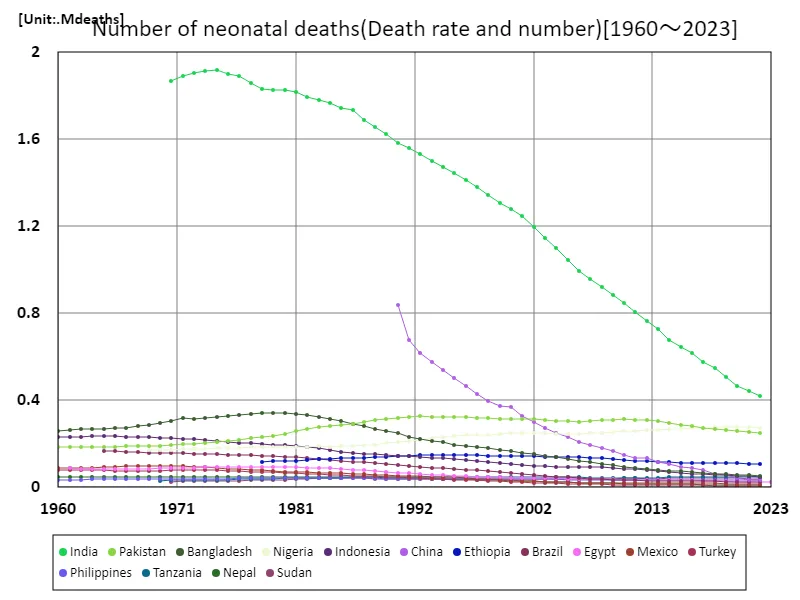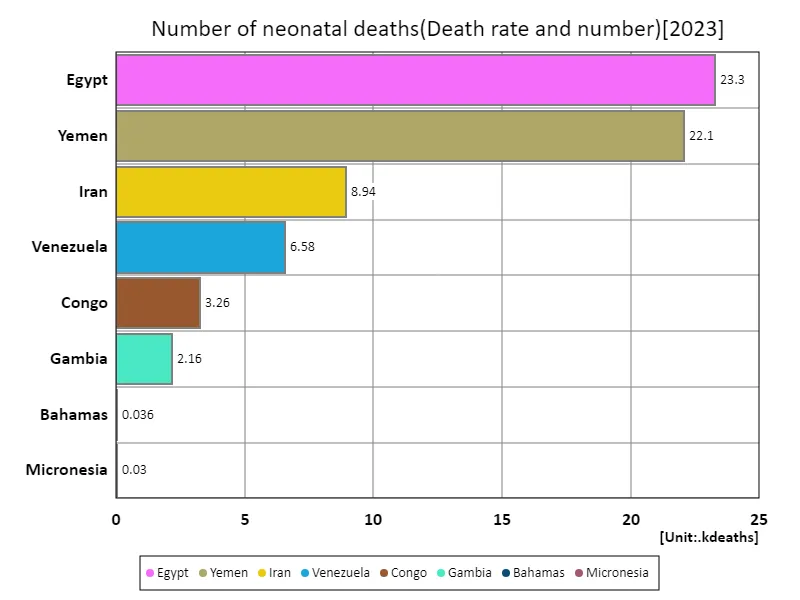Abstract
Neonatal deaths are an important indicator of global economic and health conditions. According to 2022 data, the number of newborn deaths worldwide is reported to be 2.31 million. This indicates that despite improvements in public health and advances in medical technology over the past few decades, it remains a serious challenge. Although the number of newborn deaths has been gradually decreasing in recent years, significant regional disparities remain. In particular, in low-income countries and conflict areas, neonatal mortality rates tend to be high due to a lack of medical resources and poor sanitation. In contrast, in developed countries, neonatal mortality rates have fallen significantly due to improved medical systems and widespread vaccinations. In addition, reducing the number of newborn deaths depends on improving the health management and nutritional status of pregnant women, as well as the provision of appropriate childbirth care. As international support and technological innovation progress, efforts are needed to achieve further reductions. The data reveals that many lives are still being lost and shows that more efforts are needed to achieve the Sustainable Development Goals (SDGs).
Number of newborn deaths
From 1970 to 2022, the number of newborn deaths shows a notable decrease. In particular, compared to the peak of 5.21 million in 1990, the current number of newborn deaths has decreased by 44.3%. This decline has been made possible by many factors, including advances in medical technology, improved public health policies and widespread vaccination. From the 1970s through to the 1990s, the number of newborn deaths declined slowly, but in the 2000s, the decline accelerated due to strengthened health systems and international health assistance. In particular, improving pre- and post-natal care and nutritional status are key factors in low-income countries. However, regional disparities remain an issue. Neonatal mortality rates remain high in low-income countries and conflict zones, and efforts in these areas continue to be needed. While the overall downward trend is a welcome outcome, further effort and focused resources are needed to achieve sustainable improvements.


The maximum is 5.21Mdeaths[1990] of World, and the current value is about 44.3%
Number of newborn deaths (worldwide)
Data from 1960 to 2023 shows a notable decline in the number of newborn deaths. In India in particular, the number of newborn deaths peaked at 1.92 million in 1974, but has now fallen to 21.8% of that figure. This dramatic improvement is due to advances in medical technology, improved public health, and widespread vaccinations. In the 1960s and 1970s, many developing countries, including India, had high neonatal mortality rates, which were due to lack of medical resources and sanitation. However, since the 1980s, international health assistance and government initiatives have led to rapid improvements, particularly in the 1990s and 2000s. In India, the main factors are improved maternal health care, medical infrastructure, and access to education. Nevertheless, progress in reducing neonatal mortality has been uneven across regions, and neonatal mortality remains high in some rural and poor areas. The challenge going forward is to eliminate these disparities and provide medical services equally to all regions. While the overall improvement is commendable, continued efforts are needed to achieve sustainable results.


The maximum is 1.92Mdeaths[1974] of India, and the current value is about 21.8%
Number of newborn deaths (worldwide, latest year)
According to data for 2023, the total number of newborn deaths worldwide is 66,800, with Egypt recording the highest number of 23,300. The global average is 7,420; these figures reflect regional disparities in neonatal mortality. While trends in neonatal mortality have shown a notable decline over the past few decades, there are still areas where numbers remain high. Countries with high neonatal mortality rates, like Egypt, often have poor health systems and poor public health outcomes, particularly due to lack of resources and unequal access. Meanwhile, in developed and some middle-income countries, newborn deaths have fallen significantly, attributing their success to improved vaccinations and health infrastructure. Overall, progress has been made in reducing newborn deaths, but there are significant regional variations and numbers remain high, particularly in low-income countries. To achieve this, it is essential to strengthen maternal care and improve access to medical care, and international support and efforts will continue to be important.


The maximum is 23.3kdeaths of Egypt, the average is 8.3kdeaths, and the total is 66.4kdeaths
Neonatal deaths (region, latest year)
According to 2022 data, the number of newborn deaths worldwide was 3.59 million, with sub-Saharan Africa recording the highest figure of 1.11 million. The average is 239,000, a figure that shows disparities between regions. Although there has been an overall decline in newborn deaths over the past few decades, they remain high in sub-Saharan Africa. Lack of health infrastructure, poverty, lack of education and disease epidemics are the main contributing factors in the region. In particular, poor hygiene and malnutrition have a significant impact on neonatal mortality. Meanwhile, developed and middle-income countries have seen significant declines in newborn deaths, with improvements attributable to vaccinations and access to quality health care. However, serious challenges remain in sub-Saharan Africa, and improving outcomes in these regions will require strengthening medical resources and improving public health measures. Overall, progress has been made in reducing newborn deaths, but more effort is needed to reduce regional disparities.


The maximum is 1.11Mdeaths of Sub-Saharan Africa, the average is 239kdeaths, and the total is 3.59Mdeaths



Comments